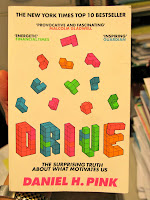Later in the evening, while she was tidying up her desk to go to bed, she suddenly blurted out excitedly, “I want to continue to work on these mathematics problems!” I confirmed with her that it was because she found it so enjoyable that she wanted to continue, even though it was time for her to go to bed.
 It was a wonderful feeling, watching my little girl basking in the deeply personal satisfaction of overcoming an academic challenge. This is the kind of internal motivation that Daniel Pink wrote of in his best seller “Drive”. I am also fully convinced that this is the best kind of sustainable motivation for everyone, including our students. Our job, as a teacher, is to help our students discover and leverage on this kind of motivation. I went to bed very happy last evening, despite the many other things on my mind.
It was a wonderful feeling, watching my little girl basking in the deeply personal satisfaction of overcoming an academic challenge. This is the kind of internal motivation that Daniel Pink wrote of in his best seller “Drive”. I am also fully convinced that this is the best kind of sustainable motivation for everyone, including our students. Our job, as a teacher, is to help our students discover and leverage on this kind of motivation. I went to bed very happy last evening, despite the many other things on my mind.
No comments:
Post a Comment